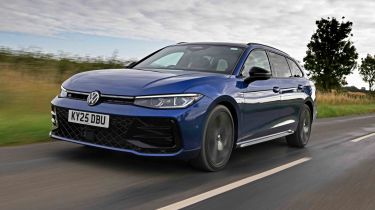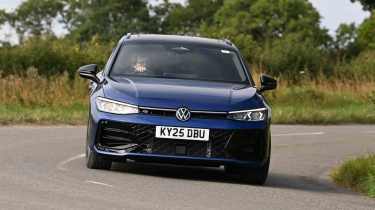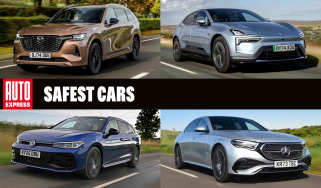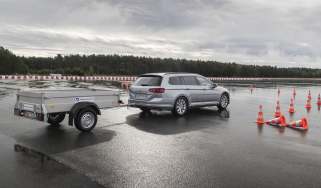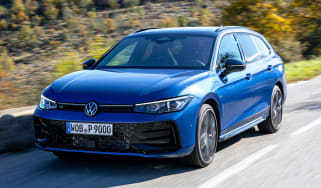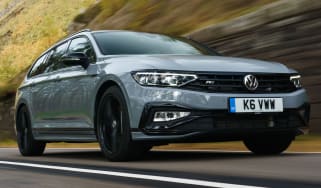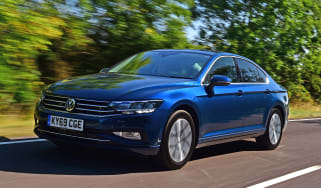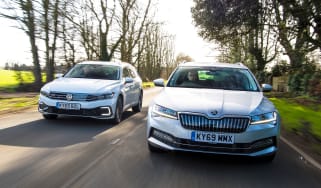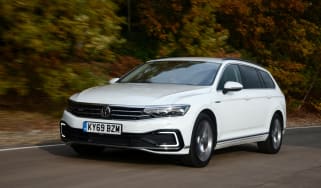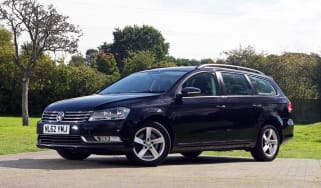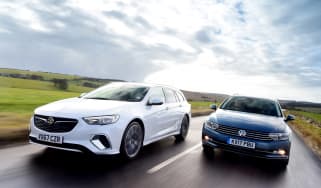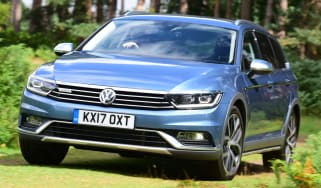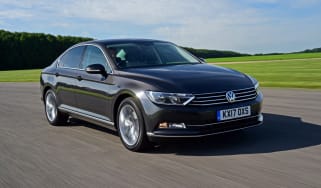Volkswagen Passat review
Our testing reveals the Volkswagen Passat is comfortable, refined, and practical, but the Skoda Superb Estate is better overall

Our opinion on the Volkswagen Passat
The Volkswagen Passat is a smart, sleek, and well-built estate car that could well have enough appeal to steer buyers away from SUVs. The plug-in hybrid model will serve company car drivers well, but private buyers should consider the excellent mild-hybrid version. It may not feel as cutting-edge as the all-electric VW ID.7 Tourer, but there’s a lot to be said for a package that’s as well-honed and resolved as this one is.
The only downside with the Passat is that its sibling, the award-winning Skoda Superb Estate, is cheaper to buy, has a slightly more user-friendly interior, and comes with a greater range of engine options. All of these reasons make it a more rounded estate choice compared with the Passat.
About the Volkswagen Passat
The ninth-generation Volkswagen Passat so nearly didn’t happen, largely because saloon and estate cars have progressively been falling victim to our voracious appetite for premium brands and higher-riding SUVs.
Yet the Passat was once a staple of Volkswagen’s range – and for good reason. Its ability to transport people and their things in a smooth, comfortable and efficient manner made for a winning formula. This is what this all-new generation is tasked with living up to.
Used - available now

2024 Volkswagen
Passat
19,502 milesAutomaticPetrol1.5L
Cash £19,902
2024 Volkswagen
Passat
7,126 milesAutomaticPetrol1.5L
Cash £21,810
2022 Volkswagen
Passat
91,512 milesManualDiesel2.0L
Cash £11,222
2022 Volkswagen
Passat
46,964 milesAutomaticPetrol1.5L
Cash £15,200It’s only available in the UK as an estate: anyone after a traditional saloon will need to look towards the Skoda Superb, which is available in hatchback and estate body styles. The Passat is powered by a selection of petrol and plug-in hybrid engines, with the latter providing around 80 miles of electric driving without needing the engine. All engines utilise the brand’s DSG dual-clutch automatic, with the 1.5 eTSI and 2.0 TSI using a seven-speed version, and the two plug-in hybrid models using a six-speed alternative.
Volkswagen Passat prices and latest deals
Prices for the Passat start from just under £40,000 for the entry-level 1.5 eTSI Life and rise to nearly £51,000 for the top-of-the-range, more potent 268bhp 1.5 eHybrid Black Edition.
If you're interested in getting yourself a Volkswagen Passat, we can help. Configure your ideal Volkswagen Passat now to get top offers from local dealers, check out the latest Volkswagen Passat leasing deals or search for used Volkswagen Passat models with our Buy A Car service. You can even sell your existing car for a great price with Auto Express Sell My Car.
Performance & driving experience
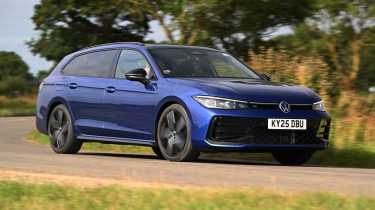
| Pros |
|
| Cons |
|
All engines in the Passat come standard with a twin-clutch DSG automatic transmission, which generally makes the most of the engine’s power. The 1.5 eTSI and 2.0 TSI petrol use a seven-speed gearbox, while the plug-in hybrids use a six-speed unit. Generally, the DSG shifts quickly in its sportier drive modes, and flicks between gears on the move in a fuss-free manner in its regular comfort mode. It could be a little more responsive during low-speed manoeuvres, though.
Currently, all new Passat cars sold in the UK are front-wheel drive. No version is available with four-wheel drive at the time of writing, unlike its contemporary, the Skoda Superb Estate. This is available with four-wheel drive on both the 261bhp 2.0-litre TSI petrol and 190bhp 2.0 TDI diesel engines. If you need better traction in slippery conditions, you’ll have to look at the Superb over the Passat, or consider a four-wheel drive equipped version of the brand’s Volkswagen Tiguan or Volkswagen Tayron SUVs.
| Model | Power | 0-62mph | Top speed |
| 1.5 eTSI 150 Life | 148bhp | 9.2s | 138mph |
| 1.5 eHybrid 204 Life | 201bhp | 8.1s | 137mph |
| 2.0 TSI 204 R-Line | 201bhp | 7.5s | 144mph |
| Passat 1.5 eHybrid 272 | 268bhp | 7.1s | 140mph |
Performance, 0-60mph acceleration and top speed
The 148bhp 1.5-litre turbocharged petrol engine manages to get the Passat from 0 to 62mph in a respectable 9.1 seconds before romping to a top speed of 138mph. It’s okay when unloaded, but it needs to be worked a bit to get up to motorway speeds with just the driver in the car, and it sounds a little unrefined when stretched, which we reckon could be an issue with a car full of people and their luggage.
If you’re likely to have more than just yourself in the car, then one of the two plug-in hybrids is a better bet. Performance figures for the 201bhp and 268bhp eHybrid versions are much better, at 8.1 seconds and 7.1 seconds, respectively. The 201bhp eHybrid has a maximum speed of 137mph, while the 268bhp version will reach 140mph.
Between the two is the 201bhp 2.0-litre petrol engine. It doesn’t have any electrical assistance, but it’s a flexible engine with plenty of pulling power when needed, achieving 0-62mph in 7.5 seconds. Like the 1.5-litre, it sounds a touch raucous when approaching the red line, but its 70Nm of torque over the 1.5 means you don’t need to stretch it as much to get up to motorway speeds. The maximum speed of the 2.0-litre is the highest in the Passat range, at 144mph.
Town driving, visibility and parking
The Passat is a big car to pilot around town, but large windows and parking sensors all around help you to judge the car’s extremities on the move.
High-end R-Line and Black Edition models (and optional on all other trims) feature a more sophisticated adaptive suspension setup called Dynamic Chassis Control - DCC for short. If you have this set-up, avoid its softest setting while going over speed bumps around town, because the ride gets a bit floaty in this setting. Selecting one of the firmer settings helps to improve body control dramatically.
We would advise you to avoid the optional 19-inch wheels (standard on Black Edition), because they exacerbate the thudding sensation you get driving over potholes, which is lessened if you stick with 17-inch wheels of Life, Match, and Elegance trims.
Country road driving and handling
Out on the open road, the standard suspension set-up that’s fitted to Life, Match and Elegance trims does a good job of keeping things calm, prioritising comfort above all and providing plenty of suspension travel.
With DCC adaptive suspension fitted, you can customise the ride from a firmer, sportier setting on twistier roads, and we found it contributed to the car feeling nice and stable with very good body control through the bends. You can also choose a softer comfort set-up on bumpier sections, and the latter certainly helps to avoid the annoying side-to-side head toss you might experience while driving down a cambered and undulating country road.
The steering remains well-weighted and accurate, although there’s little feedback, and it isn’t as sharp as the steering you’ll find on a BMW 3 Series Touring.
Motorway driving and long-distance comfort
General refinement is excellent, with good road noise suppression and very little wind whistle at speed – especially in Elegance trim cars and above, which feature laminated side windows and additional sound insulation to enhance refinement.
“I found I needed to use the auto hold function to help keep my 2.0 TSI Passat test car in place when emerging from junctions on an incline. I felt the seven-speed DSG gearbox was allowing the car to roll back more than a traditional torque converter automatic would as I moved from the brakes to the accelerator.” - Max Adams, online reviews editor
MPG, emissions & running costs
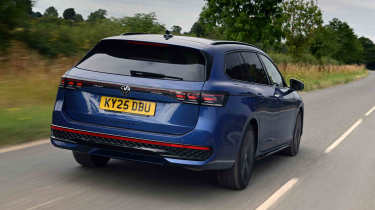
| Pros |
|
| Cons |
|
The Volkswagen Passat range begins with the 1.5 eTSI, which gets a combined fuel economy figure of 51.4mpg. Those interested in the 2.0 TSI petrol will be unsurprised to know that, because of its larger and more powerful engine, it isn’t as economical as the 1.5. However, a combined figure of 40.4mpg isn’t bad, and in our experience, it should manage around 30mpg at lower speeds around town, and above 40mpg on longer motorway runs.
The two plug-in hybrid models both have a combined figure of 706.2mpg, but in our experience with plug-in hybrid cars, you’ll need to charge frequently and use the engine very sparingly, and even then, you’re still very unlikely to achieve the claimed economy figure.
It’s worth pointing out that the 1.5 eTSI and 2.0 TSI petrol engines have a larger 66-litre tank, while the eHybrid models have a smaller 50-litre tank. This means you’ll need to stop more often for fuel with a plug-in hybrid on longer trips if you cannot charge while away from home. With mostly motorway driving, we achieved over 600 miles to a tank when testing the 2.0 TSI petrol, making it a great companion on long-distance drives.
| Model | MPG | CO2 | Insurance group |
| 1.5 eTSI DSG Life | 51.4mpg | 122g/km | 25 |
| 1.5 eHybrid DSG Life | 706.2mpg | 8g/km | 36 |
| 1.5 eHybrid 272 DSG Elegance | 706.2mpg | 9g/km | 40 |
| 2.0 TSI DSG R-Line | 40.4mpg | 159g/km | 31 |
Electric range, battery life and charge time
The VW Passat eHybrid plug-in hybrid has a 25.7kWh battery pack (19.7kWh usable capacity), providing up to 82 miles of range. That’s a lot more range than the previous plug-in Passat, plus the maximum charging speed has been increased from a slow 3.6kW to up to 40kW, with the potential to top up the battery from 5 to 80 per cent (from roughly 4 to 66 miles of electric range) in 26 minutes.
Rapid charging would be an expensive way to run an eHybrid Passat, so most will probably utilise a 7.4kW wallbox charger at home. Fully recharging an empty battery using this method should take around four hours.
The battery is covered by a separate warranty that states the battery should maintain above 70 per cent capacity over eight years or 100,000 miles.
| Model | Battery size | Range | Insurance group |
| 1.5 eHybrid DSG Life | 25.7kWh | 82 miles | 30 |
| 1.5 eHybrid 272 DSG Black Edition | 25.7kWh | 81 miles | 34 |
Insurance groups
Insurance isn’t likely to be the cheapest around, but if you want the most affordable version of Passat to insure, the entry-level 1.5 eTSI Life is in group 25. The 2.0 TSI petrol jumps up to group 31.
The plug-in hybrid starts in group 30, before rising to group 34 for the most powerful 272 eHybrid in Black Edition trim. For context, a petrol Audi A5 Avant starts in group 24, while the plug-in hybrid BMW 3 Series Touring 330e is in group 34.
Check if your car needs an MoT and view its complete history with our MoT History Checker...
Tax
Much like other plug-in hybrid cars, either eHybrid version will be best suited to a company car driver, especially considering the much more affordable Benefit-in-Kind (BiK) company car tax bill compared to a regular petrol or diesel car. An equivalent electric vehicle will still be a lot cheaper, though. Unfortunately, due to the cheapest plug-in hybrid model costing over £44,000, you’ll be clobbered by the additional road tax surcharge for cars costing over £40,000 when new, which applies from when the vehicle is taxed for a second time until it is six years old.
The 1.5-litre petrol's relatively low CO2 figure of 125g/km beats many of its similarly priced premium petrol rivals, such as the BMW 3 Series Touring and Mercedes C-Class estate. In Life trim, this is the only engine you can have in a Passat that avoids the luxury surcharge because its list price is under £40,000.
The 159g/km CO2 figure of the 2.0 TSI petrol puts it in the highest 37 per cent bracket for BiK, making it a very expensive company car choice. It’s only available in the high-end R-Line trim and comes with a price tag above £40,000.
Depreciation
According to our data experts, the Passat will retain between 47 to 49 per cent of its resale value over a typical three-year/36,000-mile ownership period. The slightly cheaper Skoda Superb Estate is expected to hold on to between 46 and 53 per cent of its value over the same period.
It’s worth noting that SUVs, which have helped to effectively kill off the estate car market, are likely to be worth more than the Passat over time. Over the same ownership period, the Volkswagen Tiguan will maintain between 52 and 58 per cent of its resale value, while the Skoda Kodaiq (which is available with seven seats) should be worth between 53 and 57 per cent over the same three-year period.
To get an accurate valuation for a specific model, check out our free car valuation tool...
Interior, design & technology
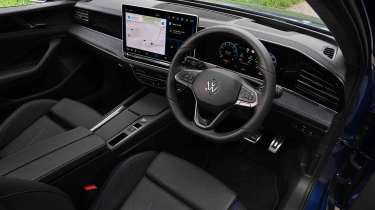
| Pros |
|
| Cons |
|
The Volkswagen Passat's exterior design has been made sleeker and less boxy than its predecessor’s. The R-Line trim has a slightly sportier look, and a rather expensive R-Line Signature pack adds larger 19-inch alloys and extra black exterior trim details (among numerous other interior upgrades).
Despite its Skoda Superb underpinnings, there aren’t as many of the ‘Simply Clever’ touches with the Passat as its Skoda sibling. So you won’t find a magnifying glass or ice scraper with the Passat, but the driver’s door contains a VW-branded unbrella for when you’re caught out in a shower, and the backs of the front seats contain small pockets for mobile phone storage. There’s even a small USB-C socket by the rearview mirror for easy installation of a dashcam, just like you’ll find with the Superb.
Five trim levels are available, starting with Life, which gets all the basics, including a 12.9-in touchscreen infotainment with sat-nav and wireless smartphone connectivity and charging, electric front seats with memory settings, front and rear parking sensors plus a reversing camera, and adaptive cruise control. Mid-range Match trim offers some high-end features like Matrix adaptive LED headlights and a 360-degree camera system.
Our preferred Elegance trim introduces some luxury touches, including:
- An acoustics pack (extra soundproofing with laminated side windows)
- Heated and cooled front seats with a massaging function
- An electric tailgate
- A panoramic glass roof
The R-Line is the sporty-looking one, featuring a black exterior trim, stainless steel pedals, and ambient interior lighting with a choice of 30 colours. The top-of-the-range Black Edition comes with 19-inch alloy wheels, a larger 15-inch infotainment screen, a head-up display system, and heated outer rear seats.
Interior and dashboard design
It is a shame that Volkswagen has introduced its much-maligned touch-sensitive climate control system in place of the physical dials used in the previous Passat.
While improvements have been made, such as making the touchscreen larger and putting frequently used climate functions on permanent display at the bottom of the screen, we would have preferred it if the designers had utilised the physical controls of the Passat’s sibling, the Skoda Superb, because they’re much easier to use on the move.
We’re pleased that the Passat hasn’t followed in the footsteps of the Volkswagen ID.7 Tourer, which has awkward-to-use touch-sensitive steering wheel controls. The Passat has much more intuitive physical controls, and it also retains the easy-to-use electric window and door mirror adjustment switches of old, rather than the confusing touch-sensitive ones featured on VW’s ID electric car range.
Those steering wheel buttons control the standard digital driver’s display, which isn’t quite as easy to navigate as the equivalent Audi Virtual Cockpit system. The column-mounted gear selector opens up extra storage in the centre console.
Materials and build quality
Inside, the quality is more in line with its sturdy predecessor than with the brand’s more recent electric car offerings, featuring high-end materials and a general sense of solidity. There are still a few hard plastics used in the lower areas you rarely look at or touch, but the bits you do see regularly remind you that you’re in a premium car.
However, the Skoda Superb has made significant strides in this area, and apart from its slightly loose-feeling rotary dials, it is virtually a match for the Passat inside. Given that it is less expensive than the Passat, we would have expected a little more from this VW.
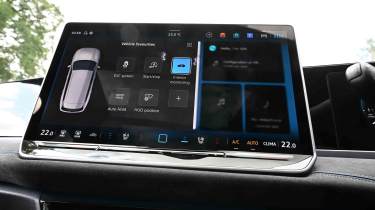
Infotainment, sat-nav and stereo
Inside, the digital interfaces are VW’s latest units, with a 12.9-inch screen taking care of all the major functions on all trim levels, apart from Black Edition, which has a larger 15-inch version of the screen with a handy head-up display (it’s available as an option for a steep £1,950 on Life and Match trims, or a more reasonable £870 on Elegance and R-Line). The head-up display is useful because it projects important information, such as speed, onto the windscreen within the driver’s line of sight.
All models come with wireless Apple CarPlay and Android Auto smartphone connectivity, as well as a wireless charging pad to keep your device fully charged. The standard audio system is an eight-speaker setup with DAB radio, but for £1,420, you can upgrade to a 700-watt, 10-speaker Harman Kardon system.
“I found that, provided you’re in the IQ Drive section of the digital instrument cluster, you can push the ‘Ok’ button on the steering wheel to bring up a small driver assistance menu where you can turn off the speed limit warning and lane keep assistance. I think that’s quite handy because it saves you from having to use the central touchscreen.” - Max Adams, online reviews editor
Boot space, comfort & practicality

| Pros |
|
| Cons |
|
It’s worth noting that, unlike its forebears, the latest Volkswagen Passat continues the 2021 decision to only sell this car in its more practical estate form.
Every Passat comes with LED headlights, with Match trim and above gaining excellent IQ.Light Matrix adaptive headlights. These are brilliant for night driving because they provide greater illumination in the dark while not dazzling oncoming traffic.
Dimensions and size
The Passat is a large estate car at 4,916mm long, 1,849mm wide, and 1,521mm tall. That makes it over 200mm longer than a BMW 3 Series Touring, and only 32mm shy of the pricier Mercedes E-Class Estate.
| Dimensions comparison | |||
| Model | Volksagen Passat | Skoda Superb Estate | Mercedes E-Class Estate |
| Length | 4,916mm | 4,902mm | 4,949mm |
| Width | 1,849mm | 1,849mm (2,090mm inc mirrors) | 1,880mm (2,065mm inc mirrors) |
| Height | 1,521mm | 1,482mm | 1,470mm |
| Wheelbase | 2,837mm | 2,841mm | 2,961mm |
| Boot space | 690-1,920 litres (510-1,770 litres eHybrid) | 690-1,920 litres (510-1,770 litres iV) | 615-1,830 litres (460-1,675 litres PHEV) |
Seats & passenger space
When pitched against a similarly priced Tiguan SUV, the Passat offers tangible benefits in terms of legroom, ride quality, and general driving dynamics, once again calling into question the validity of our far-reaching SUV obsession. Much like the Skoda Superb upon which the Passat is based, space inside is vast, whether you’re sitting in the front or the back.
As with a number of Volkswagen Group cars, the Passat comes with an Isofix child seat mounting point on the front passenger seat.
The generous amount of space up front is matched in the back of the Passat, with even taller adults (in our case, 5ft 11 in height) being able to sit behind a similarly sized adult up front. Those front seats are high enough off the floor to give you enough room to slide your feet underneath in order to stretch out. We’re yet to try an example without a panoramic glass roof, a feature which usually reduces the amount of headroom on offer, but we didn’t find our head hitting the headliner with this type of roof. Our only disappointment is that there’s a sizable central tunnel in the floor that the middle rear seat occupant will have to straddle.
A pair of Isofix points are mounted on the outer positions of the rear bench, and they’re easily accessible behind a pair of plastic tabs. Black Edition trim has standard heated outer rear seats, which can be added as an option to the rest of the range as part of the winter pack - although the price of this pack is a bit odd because it’s either £840 for Life and Match trims or £460 for Elegance and R-Line trims.
Boot space
The Volkswagen Passat’s huge 690-litre boot is 40 litres larger than before. With the rear 60/40 split-folding bench folded down, this increases to 1,920 litres – 140 litres more than in its predecessor. The plug-in eHybrid has a smaller capacity boot of 530 litres with the rear seats up and 1,760 litres with the seats down, but that’s still a decent amount of space compared with other plug-in hybrid estate cars.
It’s a shame you don’t get a more flexible 40/20/40 split folding rear bench, like those found in premium rivals such as the Audi A5 Avant, BMW 3 Series Touring, and Mercedes C-Class estate. There’s a ski hatch in the Passat, which enables you to pass through longer items, though.
Non-plug-in models feature an adjustable height boot floor, allowing the load area to be level with the tailgate opening. The eHybrid model, however, has a fixed-height boot floor, with a smaller compartment below to store the charging cables.

Towing
The 1.5 eTSI mild-hybrid has the lowest braked trailer rating of 1,600kg, going up to 1,800kg with the 204 eHybrid and 2.0 TSI petrol. Towing capacity tops out at 2,000kg for the 272 eHybrid, which is a healthy number.
The Passat makes for an excellent tow car, having won out against all other entrants of the 2026 Tow Car Awards. In 2.0 TSI guise, it proved to be a refined and comfortable tow car, with the added benefit of having a huge boot that can swallow all manner of camping equipment.
Sure, it doesn’t provide the instant power delivery of an EV, and its lack of four-wheel drive meant it struggled on our steep hill start test, but the latter is a pretty extreme test and shouldn’t prove to be a major issue in everyday life. If that does worry you, then take a look at the Passat’s Skoda Superb Estate sibling, which, in four-wheel drive equipped petrol and diesel forms, can handle up to 2,200kg.
Fitting a tow bar to your Passat is fairly pricey at over £1,000. A full-size spare wheel is available for £350.
“While it sounds like a cliche, I’ve utilised the Volkswagen Passat estate for tip runs, and it is easily big enough to take a double mattress (admittedly folded over) and a dismantled set of drawers with space to spare.” - Max Adams, online reviews editor
Reliability & safety
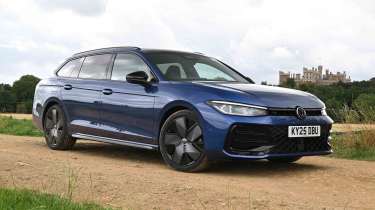
| Pros |
|
| Cons |
|
The latest Volkswagen Passat is too new to have been included in the 2025 Driver Power customer satisfaction survey. However, Volkswagen needs to do more to improve its customers' ownership experience. The brand ranked a lowly 27th out of 31 manufacturers included in the survey, narrowly ahead of stablemate Cupra in 28th place. Embarrassingly, VW finished behind Audi (19th), Skoda (12th), BMW (eighth), and Mercedes (2nd).
Safety experts Euro NCAP awarded the latest Passat the maximum five-star rating, a result shared with its sibling, the Skoda Superb. The Passat did better in the adult and child occupant protection categories than the far pricier BMW 5 Series, which is a great result. If you want something even safer, you’ll have to go electric and turn to the Volkswagen ID.7 (also available as an estate in VW ID.7 Tourer form), with superior scores in the adult, child, and vulnerable road user categories.
Like the ID.7, the Passat has all the latest safety assistance features. One is autonomous emergency braking (AEB) to mitigate or avoid low-speed collisions with other vehicles or pedestrians. There’s adaptive cruise control to keep you at a safe distance from the vehicle in front, plus a lane departure and lane keep system to keep you within your lane on the motorway. Blind spot monitoring is also standard, warning you of vehicles in your blind spot when you attempt to change lanes on the motorway.
Additional side airbags for rear seat passengers are a £400 option that’s bundled in with the addition of a tyre pressure monitoring system.
| Euro NCAP safety ratings | |
| Euro NCAP safety rating | Five out of five stars (tested in 2024) |
| Adult occupant protection | 93% |
| Child occupant protection | 87% |
| Vulnerable road user protection | 82% |
| Safety assist | 80% |
Buying and owning
Our best buy: Volkswagen Passat 1.5 eTSI Elegance
Even though estate cars like the Volkswagen Passat have fallen out of fashion in favour of SUVs, the latest Passat still cuts it as a great family car that’ll cope with a long motorway trip just as easily as a jaunt to IKEA for some oversized flat-pack furniture, and it’s filled with tech, giving it a greater breadth of ability than ever before. The plug-in hybrid offers a useful electric range and low (on paper, at least) emissions, providing company car drivers with an affordable offering.
If you are a company car driver, then the least expensive 201bhp 1.5 eHybrid plug-in hybrid (PHEV) is your best option. All versions of the PHEV cost over £40,000 when new, so you might as well pay a little bit more for Match trim because it’ll have the same annual vehicle excise duty (VED), but come with some welcome extras. Private buyers will undoubtedly opt for the more affordable 1.5 eTSI mild-hybrid petrol, and appreciate the better long-term residuals and high equipment level of the Elegance trim.
Those who mostly drive around town completing short journeys will be on the more frequent fixed service plan, which requires yearly trips to the dealer for servicing, or every 10,000 miles. Anyone driving more on the motorway will be on a variable service scheme, with longer two-year maintenance visits, or every 18,600 miles.
Volkswagen Passat alternatives
While the Passat offers a lot more practicality and higher equipment levels than similarly priced premium estate cars, such as the Audi A5 Avant, BMW 3 Series Touring and Mercedes C-Class Estate, it’s pricier than the closely related Skoda Superb Estate.
The Superb has a greater choice of engines, and, according to our data, should hold its value similarly well. The Superb also has a more user-friendly interior owing to having more physical controls, so we’d suggest you try a Superb first before committing to a Passat. You can also opt for the Superb Estate with four-wheel drive in both 2.0 TSI petrol and 2.0 TDI diesel forms, which may be particularly important for those who tow regularly on damp grass on caravan sites.
Deals on the Volkswagen Passat and alternatives
Volkswagen Passat pictures
Frequently Asked Questions
The standard Volkswagen manufacturer’s warranty is three years or 60,000 miles, which is beaten by many manufacturers that offer five years or more of coverage.
